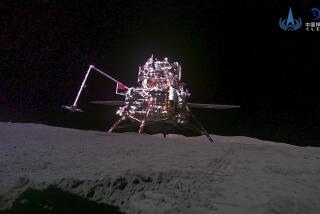Curiosity bites into Mars, and it tastes like Earth
NASA’s Curiosity rover has bitten into Martian turf at a site called Rocknest and revealed soil remarkably akin to volcanic soils on Earth, scientists at Jet Propulsion Laboratory said Tuesday.
Nearing the end of its third month roving the Red Planet, the “bites” into the Rocknest dune mark the Mars Science Laboratory rover’s first result from its chemistry and mineralogy instrument -- CheMin for short -- which bombards soil samples with X-rays to reveal their mineral composition and abundance.
The minerals in the soil sample analyzed this week resemble “some weathered basaltic material that we see on Earth … on the flanks of Mauna Kea in Hawaii,” said CheMin co-investigator David Bish, of Indiana University in Bloomington.
Since landing in Gale Crater on Aug. 5, Curiosity has already tasted elemental abundances. It has touched rocks with the alpha particle X-ray spectrometer at the end of its arm, and shot the ChemCam laser on its mast at spots up to 23 feet away to analyze the rock it vaporizes.
But knowing the elements doesn’t quite tell scientists what exactly the rocks are, because those elements can be arranged in crystal structures to form very different minerals. Carbon, for example, can occur as graphite -- the soft, dark, greasy mineral used in pencils -- or as diamond (which, though it may no longer be the absolute hardest natural substance known, is reputedly still a girl’s best friend). It all depends on how the carbon atoms are connected.
Scientists need to know how these elements are arranged into minerals, because those minerals will reveal more about Mars’ history, how it formed and whether it was ever capable of supporting life.
That’s where CheMin comes in. It’s one of two instruments in the lab in Curiosity’s belly that can ingest and analyze Martian soil. Curiosity uses a scoop at the end of its arm to collect soil. Then it sieves grains no larger than 150 micrometers (roughly the width of a human hair) and drops a tablet-sized portion into CheMin, which bombards the sample with X-rays to see the pattern of light and shadow the X-rays cast that reveals its mineral structure.
The results, though largely expected -- including pyroxene and olivine, hallmarks of Earth’s mantle, and plagioclase feldspar, common in our planet’s crust -- were a first of their kind, filling in gaps in the current understanding of Mars’ surface and thus thrilling members of the science team.
“If it got any better, I could not stand it,” said CheMin co-investigator Doug Ming, based out of NASA’s Johnson Space Center in Houston.
Scientists are also looking forward to results from the other lab tool in the rover’s belly, called sample analysis at mars, which measures the abundances of lighter elements like nitrogen, hydrogen and oxygen -- elements necessary for living things.
Curiosity’s ultimate goal in its two-year mission is Mt. Sharp, a 3-mile-high mountain in the middle of Gale Crater whose lower layers may hold clues to whether Mars contains the ingredients for life.
Follow me on Twitter @aminawrite.







